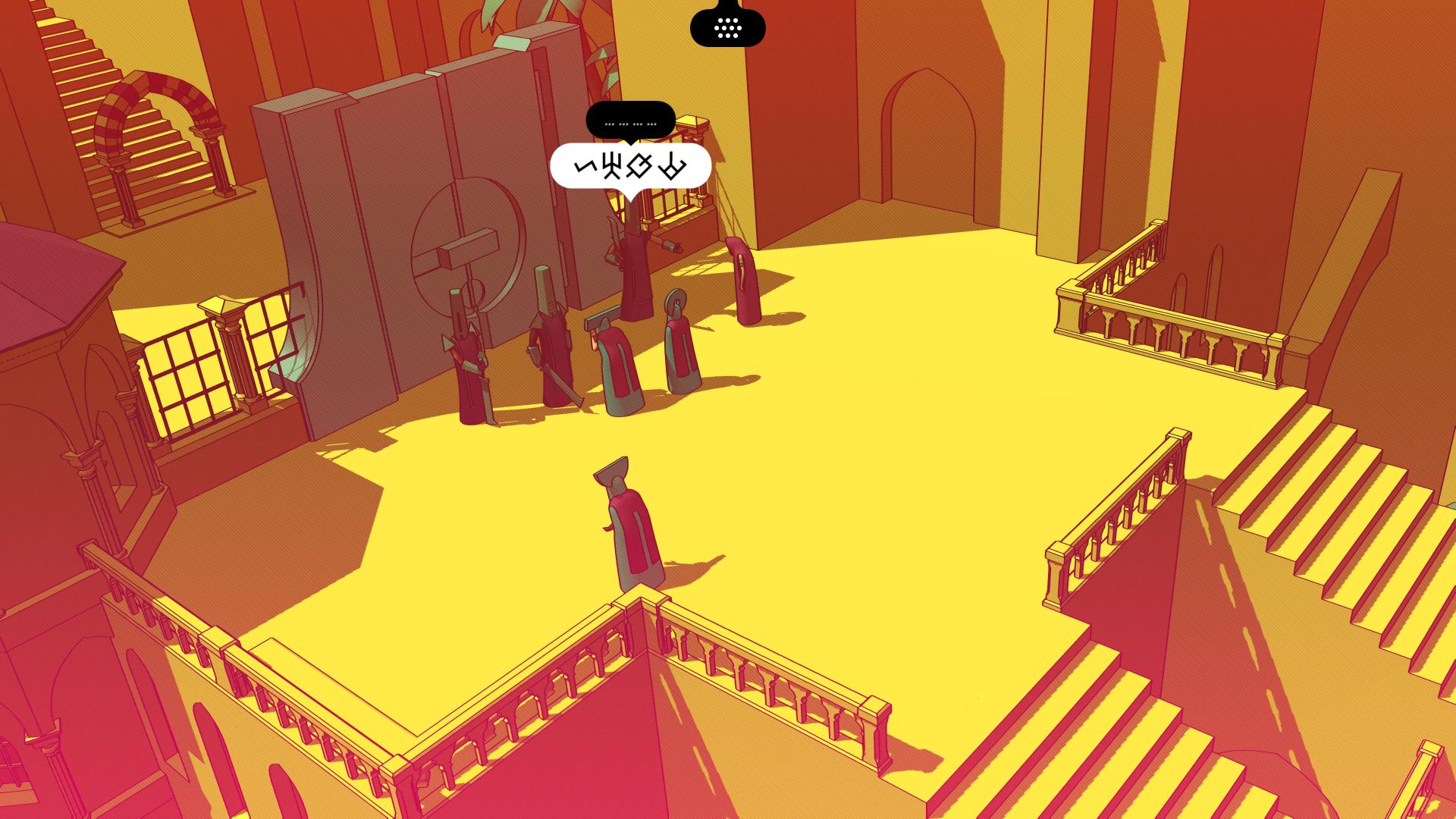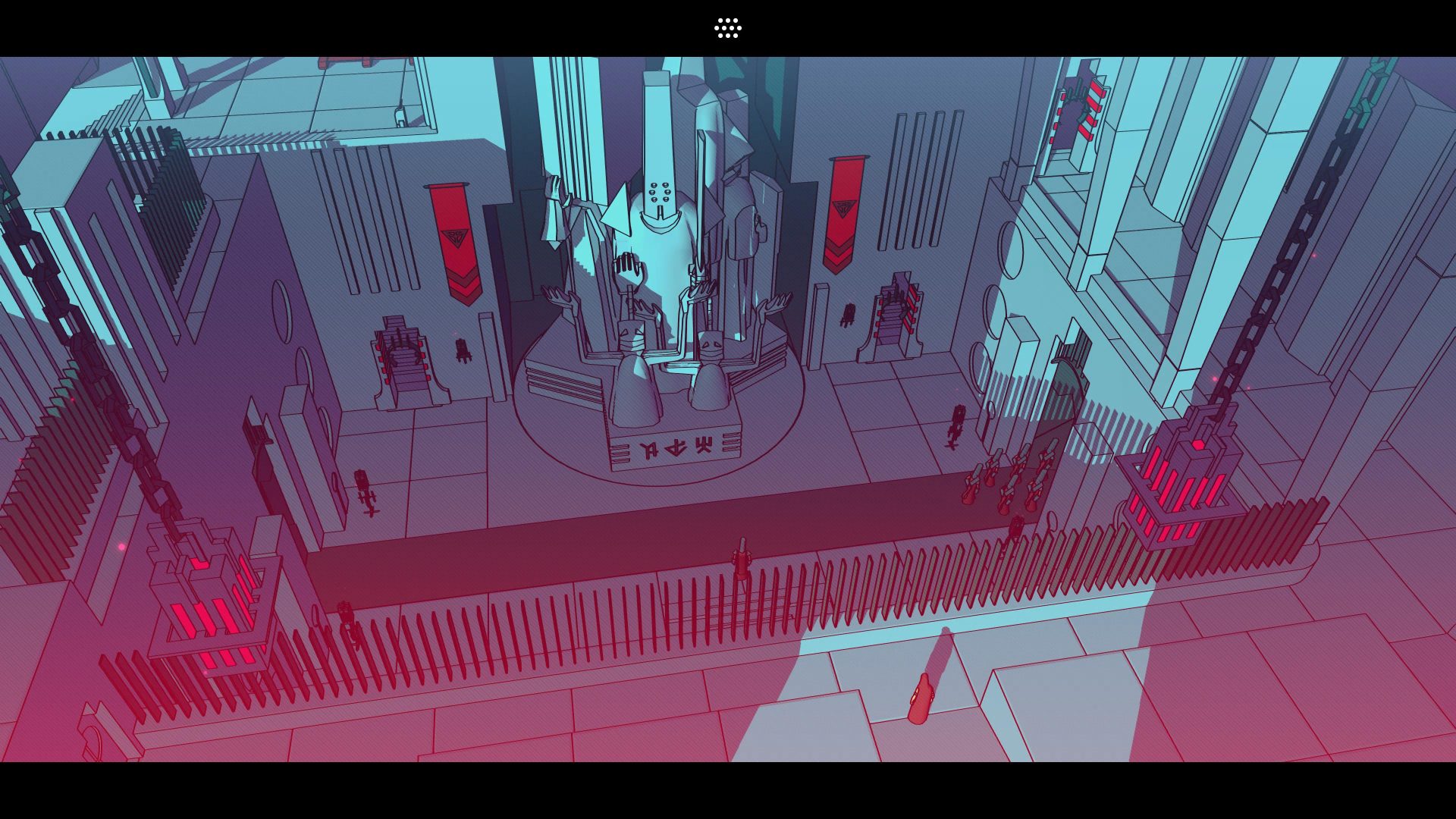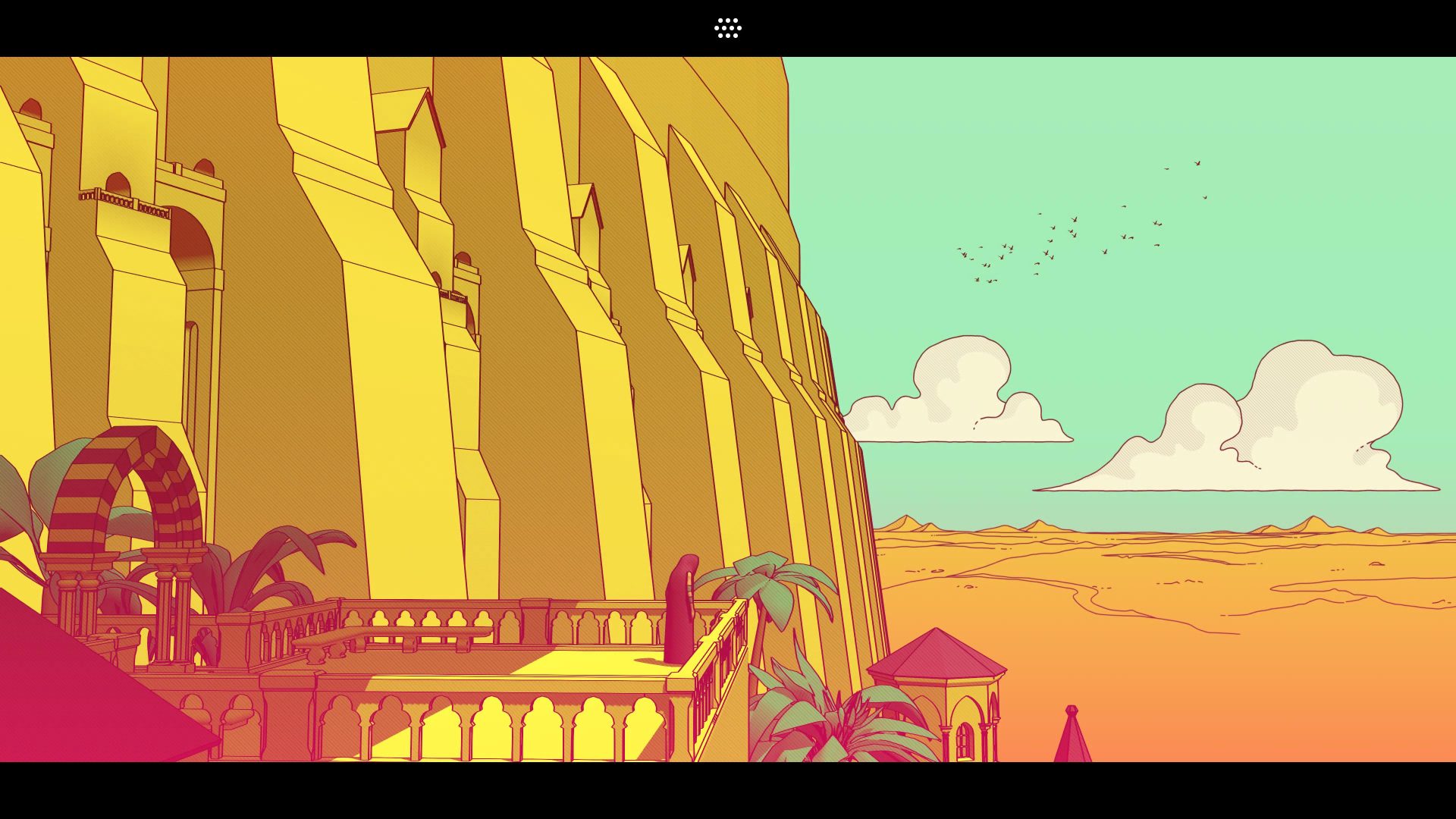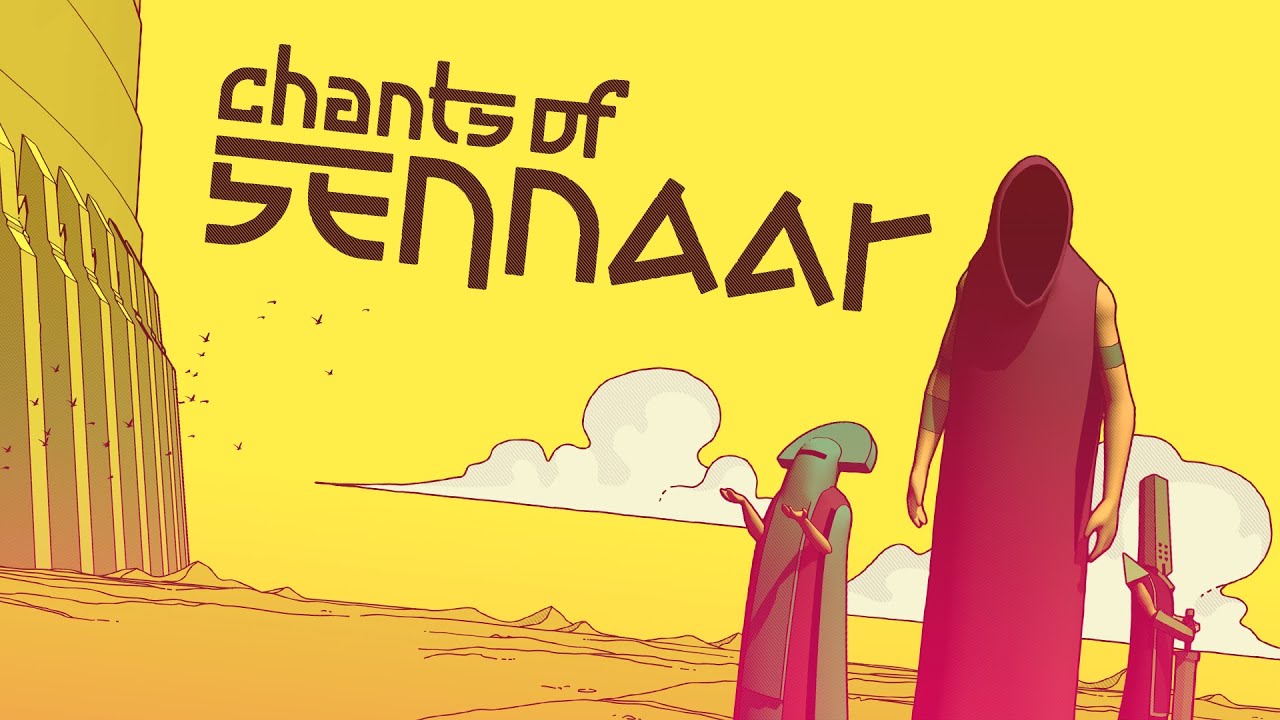Being multilingual may as well be a superpower as far as I’m concerned. Growing up in a small town in Tasmania, the closest I’ve ever come to speaking anything other than bog-standard English is understanding the mumbled ramblings of shearers. Being able to travel freely in a foreign country without using Google Translate or even bridge the gap between two people who can’t understand each other is something special. This sentiment is at the heart of Chants of Sennaar, a puzzle adventure game by small, French indie developer Rundisc. Focusing on language and the connections and separations that can come with it, Chants of Sennaar is clever, visually distinct, and regularly challenging, but do these positive aspects get lost in translation, or are they universally understood?
Without a sniff of context, our hooded protagonist wakes from their slumber, rising from a ceremonial alter. With no recollection of who they are or where they are, you’re left to wander into the maw of a vast, foreboding tower. Your first obstacle is a stream of water that blocks your path, though, luckily, a series of nearby levers seems to control its depth. Less fortunate are the unfamiliar symbols emblazoned on the wall nearby, telling you which levers need to be raised and which lowered. Jotting these symbols down in an in-game notebook, you’re now tasked with finding clues within the world that might help decipher these markings.
Before your deductions are confirmed, it’s up to you to keep your findings documented using this in-game journal. Once you attach a word to a symbol, that word will be shown below the relevant glyph in the game world, letting you see if your guess fits the bill. Clues to the symbol’s true definitions are plentiful if you’ve got a keen eye. The glyph for pot may be found above a shop where a worker is throwing clay, fruits of a trial-and-error attempt at a numbered sequence to unlock a door may bear fruit and conversations with the tower’s denizens may reveal previously mysterious symbols once your lexicon expands somewhat.

Hmm, I think that’s a door
Once the game recognises that you’ve interacted with enough clues, our silent lexicologist will sketch images depicting actions, ideas, or phrases. Having carefully taken notes, you’ll then be able to match the glyphs to these drawings, with their meaning confirmed if you place them correctly. Successfully uncovering the meaning of the glyphs is very satisfying, not only because you feel like a fast-learning detective but also because the newly understood words are then slotted into conversations and signs, allowing you to unravel the mystery further.
An issue arises, however, if you fail to take studious notes or don’t quite manage to interact with every necessary item or person, leaving you clueless as to what these etchings are hinting at, or, worse still, without the option to guess at all. Moreover, these illustrations often depict formless ideas that (for the most part) are legible but can also leave you needing clarification as to what you’re looking at, even if you do know what the corresponding glyph represents. I had to brute force a few of these by process of elimination, which killed the puzzle-solving buzz, but the majority are well implemented.
Each level of the tower that you explore is vast and labyrinthian, and I found myself getting lost on the regular. This quite accurately depicts what it’s like to travel to a distant land where you don’t speak the native tongue; in fact, it does that a little too well. I frequently got lost as I looked for clues and connections or while I tried to get back to a specific spot, which somewhat dampened my thirst for knowledge.

I don’t think they’ll appreciate mispronunciation here
Other puzzles require you to find a particular item that will interact with something else in the world, like point-and-click adventure games of old, while other sections have you doing some light stealthing. The mechanic itself is simple, as you move from one hiding spot to another with the press of a button, and the windows of opportunity are forgiving, but the reliance on these moments becomes too heavy on certain levels of the tower.
Easily the most interesting challenge of the game comes when you begin to ascend the tower. Starting at the structure’s base among the lower class, you learn the language, become familiar with the customs of the peaceful, cloaked citizens, and begin your climb. But, instead of finding more of these friendly followers of an overseeing god, the next level of the tower is home to a militaristic and oppressive warrior race that only understands violence.
Each level of the tower houses its own culture, set of rules and expectations and, most importantly, its own language. That’s right, you’re not just learning one language, but six. Arriving at each level, you’ll be sent back to square one with a list of glyphs that won’t resemble the last in any way that’s immediately apparent. Items that include multiple languages will allow you to translate a few words directly, otherwise you’re back to being a foreigner in a foreign land. Wonderfully, these different dialects don’t all have one-to-one equivalents either, as each culture has its own sentence structure and grammar to understand, adding another layer of complexity to your task.

There’s something enchanting about the bright colours and thick lines
As you climb the tower, you’ll uncover a shared history between the fragmented cultures, complete with a hierarchy and various belief systems. Slowly understanding the part that each group plays in the overarching narrative is intriguing, and the drip-feeding of information kept me interested throughout my ten-hour playthrough. Each of the levels seems loosely inspired by real-world cultures, with the aesthetics and glyphs feeling similar to Nordic, Middle Eastern and medieval civilisations, to name a few. The story also shares many parallels with the myth of the Tower of Babel, with those connections becoming more prominent the higher you climb. It’s a narrative that gripped me from the beginning, and I was eager to see it through to its satisfying conclusion.
The cultures and languages are vastly different on each level, as are the visuals and music. Colour palettes and architecture change to depict the cultures’ ideologies and character, from the greys and reds found on the brutalist structures on the warrior’s level to the warm yellow tones of the Greek-inspired villas of the artist’s level. Each new area is filled with sites worth exploring and a history worth learning, and I never grew tired of one before I was whisked away to the next. The music evolves similarly, effectively portraying each group as you ascend.
Final Thoughts
A genuine pursuit of knowledge, Chants of Sennaar is a wonderfully clever game that asks the player to learn continuously. The stealth components wore thin, and the size and scale of the locations hampered the puzzle solving, but my desire to explore and discover always overcame these setbacks. An ever-changing aesthetic and a core mechanic that refuses to let you get too comfortable should be more than enough for you to crack open your notebook and learn to speak more than English and shearer.
Reviewed on PS5 // Review code supplied by publisher
Click here for more information on WellPlayed’s review policy and ethics

- Rundisc
- Focus Entertainment
- PS4 / Xbox One / Switch / PC
- September 6, 2023



Adam's undying love for all things PlayStation can only be rivalled by his obsession with vacuuming. Whether it's a Dyson or a DualShock in hand you can guarantee he has a passion for it. PSN: TheVacuumVandal XBL: VacuumVandal Steam: TheVacuumVandal






























